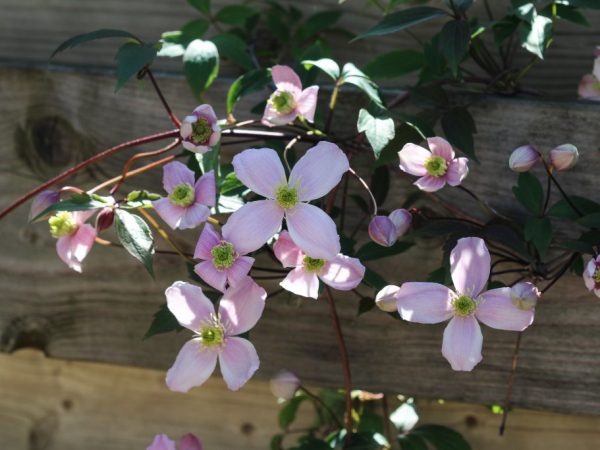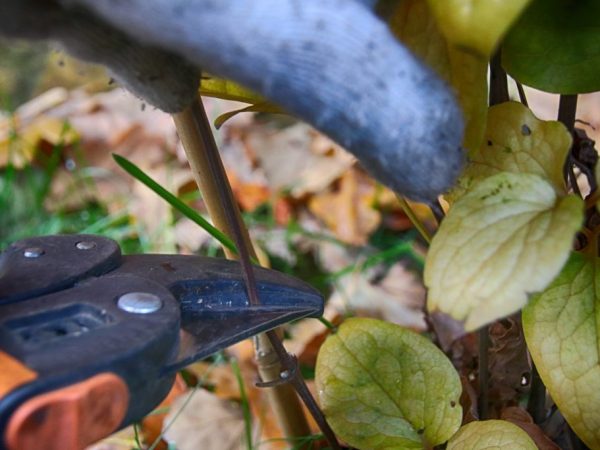Reproduction of clematis by cuttings
To diversify the number of clematis varieties at home, you need to learn how to propagate this plant. Reproduction of clematis in autumn is best done by cuttings - this is the easiest way.

Reproduction of clematis in the fall
general information
Clematis can be propagated either in spring or in autumn (the most favorable period is in October).
To obtain a new plant, the following methods are used:
- seeds;
- division of the plant;
- layering;
- by cuttings.
To plant large-flowered varieties at home, only vegetative propagation is used.
How grafting is carried out
To propagate clematis by seeds, any convenient time will do.
Cuttings have a time frame that depends on the shoots. Basically, a new flower is planted in the spring. Although the most successful time is the first month of summer. At this time, the shoots are rich in natural biological stimulants and the first buds appear on them. Reproduction of clematis by cuttings in the fall requires a lot of effort, since it is more difficult for the shoots to take root at this time.
How to cook cuttings
To propagate the plant in the fall, it is necessary to prepare healthy shrubs that are 2 to 4 years old. The flower grower cuts cuttings at a height of 20-30 cm from the ground. New root systems form lateral stems faster, which grow in spring after careful pruning of the bush. You should not take shoots from the top of clematis, because no matter when they are pruned in spring or autumn, the end result is the same - poor rooting. Single-node cuttings acclimatize better.
Planting a new flower by layering is done in several stages:
- Preparatory: the florist prepares a sharp knife or scissors in advance.
- Basic: to propagate clematis with cuttings, a knife or scissors, a small straight cut is made, a couple of cm above and 4-5 cm below the node. The large upper leaves are shortened by half or by a third, the lower ones are completely cut off.
- Completion: until planting in open ground begins in the fall, the cuttings are kept in containers with water in the shade.

A florist cuts off clematis cuttings at a height of 20-30 cm from the ground
How to root a scion
If you carry out cuttings of clematis in the fall, then you need to take care of where to root it. There are a few simple options to suit different climates.
Plastic cups
These small containers are great for cuttings. They clearly show what is happening with the plant: do the first roots appear and when does this happen?
Drainage holes are pre-made in a plastic cup. Then it is filled with a small amount of soil (the principle is similar to planting with seeds) or perlite. After that, the contents are well irrigated with water. The stalk is dipped in the root, then it is stuck into the container. This is done so that there is only half of the internode in the soil.Those who are engaged in propagation by layering know that if you completely cover the cutting, the plant will not be able to root and grow normally.
The soil
Propagation by cuttings followed by rooting into the soil is carried out in greenhouses with foil or glass insulation. The flower grower carefully digs up the soil, on which a small paper box is placed. The substrate for clematis must be clean (i.e., free of pathogenic microorganisms, weeds seeds). It is good when the soil has a water-retaining characteristic. To avoid excessive water content in the soil and maintain normal temperature values, the soil is also made two-layer. The bottom layer consists of peat and sand, or from these components and humus, all in equal proportions. The upper one is purely sandy. Before rooting, the earth is spilled with a weak solution of potassium permanganate (based on a bucket of water 4-5 g).
To speed up the process, the material is additionally treated with special growth agents. 1.5-2 g of Na is dissolved in 1 liter of liquid or "Heteroauxin" is diluted in 500 ml of water. The cuttings are left in solution for 10-12 hours, then washed with clean water and planted in the ground.
Water
Another option in which clematis is rooted. To do this, take a glass container with a wide neck, an ideal bank. Water is poured into it so that only the ends of the processes touch the liquid. The jar is wrapped in a cloth or wrapped in newspaper so that the direct rays of the sun do not fall inside.
If inside the room where clematis is bred to maintain the same temperature, then in 1.5 - 2 months a new full-fledged root system is formed in the cuttings. The main thing is to constantly add water so that the same liquid level is maintained inside the container.
As soon as the root grows and grows in length up to 4-5 cm, the flower is planted in the ground. You cannot keep the plant in water longer than it should be, this negatively affects clematis, its buds begin to dry out, and the roots outgrow and become entangled.
Bottle
This option greatly simplifies the process of plant propagation. The bottle is cut into two halves, exactly in the middle. The upper part is removed, small holes are made in the lower part and covered with a substrate. The stalk is planted in the middle of the bottle, then it is closed, and wrapped with tape at the cut.
The plastic container is buried in the ground, at ground level - then overheating can be avoided. After 14 days, the bottle is opened for 15-25 minutes. When the first shoots appear, the plugs are removed for good.
Other options
For rapid reproduction at home, rooted clematis are planted in pots or plastic bags. In winter, these containers are kept in flower greenhouses and are occasionally irrigated. The ambient temperature ranges from 2 to 8 ° C. In the last decade of February, the temperature gradually increases to 16-17 ° С. In the middle of spring, new cuttings are removed from these plants. After 45-60 days, the procedure is repeated, and the main (uterine) bush is planted in the ground.
Temperature background
It is very difficult to ensure the optimal temperature regime for normal root formation. It is good when the cuttings are transplanted at 20-24 ° C. Indicators above have a detrimental effect on the flower. On hot days, the chances of survival of the cuttings are reduced.
Conclusion
Among all the options for autumn breeding of hybrid and species clematis, the simplest and most promising is cuttings. It does not require any special training or any special tools. The main thing is to follow the basic rules.


